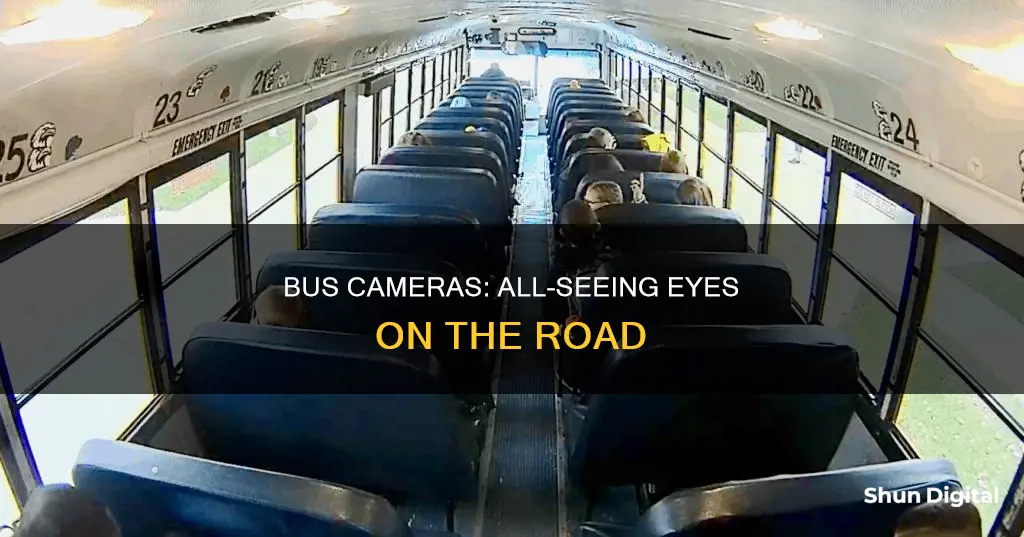
Bus cameras are an increasingly common feature on public transport services and school buses. They are used to monitor both the behaviour of passengers and drivers, and to capture any incidents that may occur during the journey. Bus cameras can be both internal and external, with some featuring audio recording capabilities. While they are not a legal requirement in the UK, they are recommended for safety and security reasons. In the US, 18 states have laws permitting the use of bus cameras, with several others allowing individual school districts to make the decision.
| Characteristics | Values |
|---|---|
| Purpose | To ensure the safety of passengers and staff, and to protect the bus company. |
| Camera Placement | Inside and outside the bus, including the driver's seat, passenger entrance and exit doors, and the top and bottom of staircases. |
| Camera Features | High-resolution, wide dynamic range, infrared illumination for night vision, audio recording. |
| Number of Cameras | Between 5 and 24 cameras, depending on the size of the bus. |
| Footage Usage | Evidence for court, insurance claims, police investigations, disciplinary action in schools, and employee training. |
| Privacy Concerns | Potential invasion of privacy, especially with audio recording. Stickers or signs are posted to alert riders about recording devices. |
What You'll Learn

Inside and outside buses
Buses are equipped with multiple cameras, both inside and outside the vehicle. The number of cameras varies depending on the size of the bus, with larger buses requiring more cameras to minimise blind spots. On average, a bus will have between 5 and 24 cameras.
Inside the Bus
Interior cameras are typically placed near the roof of the bus to capture as much of the bus interior as possible. These cameras are often dome-shaped and black in colour. They are used to monitor passenger behaviour, discourage bullying, and resolve conflicts or allegations. In the case of school buses, interior cameras can ensure child safety by allowing authorities to monitor student behaviour and look out for suspicious individuals or objects.
Outside the Bus
Exterior cameras are usually placed at the front, back, and sides of the bus. They are either yellow or black and wedge-shaped, with a transparent opening. These cameras serve several purposes, including capturing license plate details of vehicles that illegally pass school buses, providing evidence in the event of accidents or incidents, and monitoring the area around the bus to assist the driver.
Camera Functionality
Most bus cameras are equipped with wide dynamic range (WDR) technology, which helps balance lighting conditions and provides clear footage even in low-light or high-contrast environments. Additionally, some cameras have infrared illumination capabilities, enabling them to capture images and videos in the dark. However, infrared illumination may affect the colour accuracy of the footage, making all objects appear grey.
While the primary purpose of bus cameras is visual surveillance, some are also capable of audio recording. This feature is often included in driver-specific cameras to capture conversations and sounds near the driver's area. However, the inclusion of audio recording devices has raised privacy concerns among civil liberties advocates.
Vloggers' Secret: Seeing Themselves on Camera
You may want to see also

Audio and video recording
Buses are increasingly being equipped with audio and video recording devices, which are often positioned near the driver. While video recording has been commonplace on public transit for decades, the addition of audio recording has sparked concerns among civil liberties advocates about the erosion of privacy.
Audio Recording
Audio recording devices on buses are capable of capturing conversations between passengers and can be always-on or triggered by specific events such as a crash, sudden movement, or the driver pressing a button. In some cases, audio recording may be limited to the driver's area, while in others, it may cover a larger portion of the bus. The inclusion of audio recording is intended to capture what drivers say and any relevant sounds that could provide context in the event of an incident. However, this also raises privacy concerns as personal conversations between passengers could potentially be recorded.
Video Recording
Video recording on buses is typically achieved through the use of multiple high-resolution CCTV cameras strategically placed inside and outside the bus. These cameras can monitor passenger behaviour, detect suspicious activities, and capture footage of passing vehicles or pedestrians. The exterior cameras are often positioned at the front, rear, and sides of the bus, while interior cameras are usually mounted near the roof or window level. The footage from these cameras can be used for conflict resolution, investigating allegations, and ensuring the safety of passengers and drivers.
Benefits and Concerns
The use of audio and video recording on buses offers several advantages, including improved safety, conflict resolution, and deterrence of bullying or misconduct. It can also aid in monitoring illegal passing, covering blind spots, and capturing evidence in the event of an accident or incident. However, there are valid concerns about the potential invasion of privacy, especially with the inclusion of audio recording. It is important to balance the benefits of surveillance with the right to privacy, ensuring that any recorded information is securely stored and accessed only when necessary.
Watching Surveillance Station Cameras on Your TV
You may want to see also

Safety and security
Bus cameras are an important safety and security measure, protecting passengers, drivers, and other road users. They are particularly useful in reducing safety risks for school children travelling to and from school. Cameras can help to ensure child safety inside the bus, discourage bullying, and resolve conflicts. They can also be used to monitor illegal passing, cover blind spots, and prevent driver misconduct.
Bus cameras can also act as a deterrent for criminal activity and help to protect drivers and passengers from potential threats. In the event of an accident or incident, such as an attack on a driver or a complaint of misconduct, camera footage can be accessed and reviewed. This can be used to take prompt action, as well as for disciplinary or legal purposes.
In terms of placement, bus cameras are typically positioned both inside and outside the bus. Inside the bus, cameras are usually mounted near the roof to capture as much of the interior as possible. Outside the bus, cameras are often placed at the front, back, and sides of the vehicle to monitor passing vehicles and pedestrians. Additionally, cameras may be installed at the bottom of the stairs on double-decker buses, displaying scrolling images of the footage being captured to reassure passengers and deter criminal activity.
It is important to note that the use of audio recording in bus cameras has raised concerns among privacy experts. While audio recording may be useful in capturing important information, it can also infringe on the privacy of individuals who may believe their conversations are not being recorded. As a result, it is crucial to balance safety and security needs with the privacy rights of individuals.
Spot Hidden Pinhole Cameras: Quick Tips and Tricks
You may want to see also

Privacy concerns
The presence of cameras on buses raises legitimate privacy concerns among passengers and the general public. While the primary purpose of these cameras is to enhance passenger safety and deter criminal activity, it is important to address the potential implications for privacy. Here are some key considerations:
Transparency About Capabilities
One of the main concerns is the lack of transparency about the capabilities of bus surveillance systems. Passengers are often unaware of whether the cameras are equipped with audio recording capabilities in addition to video. While video surveillance may be justifiable for public safety, the inclusion of audio raises questions about invading privacy. To address this concern, transportation authorities and bus companies should clearly communicate with passengers about the extent of surveillance, including any audio recording.
Data Retention and Access
Another significant concern is the retention and access to recorded data. Clear guidelines and regulations are necessary regarding the storage and deletion of audio and video recordings. Without proper safeguards, recorded conversations could be retained indefinitely or accessed without authorization. Transportation authorities must establish strict protocols to protect passenger privacy and ensure that access to recorded data is limited to authorized personnel only.
Potential for Abuse
There is always a risk that bus surveillance systems could be misused. Unauthorized access to recorded data, misuse of audio recordings, or inappropriate sharing of sensitive information are all potential abuses that need to be addressed. Robust security measures, regular monitoring, and audits of the surveillance systems are essential to prevent such abuses and ensure they are used solely for their intended purpose.
Balancing Safety and Privacy
As bus surveillance systems become more prevalent, striking a balance between public safety and individual privacy is crucial. Clear communication, transparent policies, and strict regulations are necessary to alleviate concerns and ensure that the use of bus surveillance is both justified and respectful of passengers' privacy rights.
Compliance with Privacy Laws
To comply with privacy laws and regulations, bus companies, and transit authorities may choose to refrain from enabling audio recording capabilities. In many jurisdictions, recording audio without explicit consent is considered a violation of privacy rights. By prioritizing video-only surveillance, bus operators can enhance safety while also adhering to legal requirements and protecting passenger privacy.
Archicad Camera View: How to Access and Utilize This Feature
You may want to see also

Placement and positioning
The placement and positioning of bus cameras are crucial aspects to consider when installing a bus CCTV system. The primary purpose of bus cameras is to capture clear footage of both the interior and exterior of the bus, ensuring that there are minimal blind spots. The number of cameras required will depend on the size of the bus, with larger double-decker buses typically needing more cameras than smaller vehicles.
For exterior cameras, it is common to have one forward-facing camera at the front of the bus, two rear-facing cameras at the back, and one camera on each side of the vehicle to monitor passing vehicles and pedestrians. These exterior cameras help cover the areas immediately in front of and behind the bus, which are often blind spots for the driver. They also assist in capturing any instances of illegal passing, which is a significant safety concern for school buses.
Interior cameras are typically placed near the roof-level inside the bus, providing a bird's-eye view of the passengers and the driver. This positioning allows for the monitoring of student behaviour, the detection of suspicious activities, and the resolution of conflicts or bullying incidents. Additionally, cameras can be positioned to monitor the passenger entrance and exit doors, ensuring the safety of passengers embarking and disembarking the bus.
In terms of wiring, wired cameras are generally recommended over wireless cameras due to the latter's issues with signal loss, weather interference, and lower image quality. Wired cameras ensure a more reliable connection and can be strategically positioned to minimise the visibility of wires.
When considering placement and positioning, it is also essential to comply with legal requirements and privacy concerns. While bus CCTV is not a legal requirement in the United Kingdom, any installation must remain GDPR-compliant, ensuring that camera footage is securely stored to protect individuals' privacy.
Overall, the placement and positioning of bus cameras should be carefully planned to maximise coverage, minimise blind spots, and ensure the safety and security of passengers, drivers, and other road users.
Unblocking Websites: A Camera Chrome Guide
You may want to see also
Frequently asked questions
Bus cameras are used to ensure the safety of passengers, drivers, and other road users. They can also help reduce insurance costs and meet safety requirements.
Bus cameras are typically placed inside and outside the bus. Inside the bus, cameras are usually mounted near the roof to capture as much of the interior as possible. Outside the bus, cameras are often positioned at the front, back, and sides of the vehicle to monitor passing vehicles and pedestrians.
Bus cameras can capture both video and audio footage. Video footage is typically in high definition, while audio recording devices capture conversations and other sounds near the driver or inside the bus.
Bus cameras are activated when the engine starts and can continue recording even after the engine is turned off. Some cameras are constantly recording, while others are triggered by specific events such as a crash, sudden movement, or the driver pressing a button.







